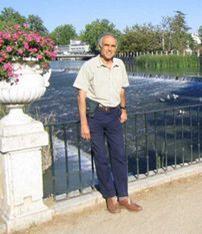
With the potential to alleviate the hunger problem in the world, the “Geshem Project” (Geshem is the Hebrew word for rain) hopes to turn myth into reality. The team plans to produce rain in sub-tropical areas during the cloudless summer months by altering air currents using a unique thermal material developed in Israel.
Led by Professor Leon Brenig of the University of Brussels’ Department of Physics, Project Geshem partners are researchers from Israel’s Ben Gurion University of the Negev, teamed with computer analysts at UCLA in California and space imagery experts from NASA.
The technique involves spreading a large black solar-absorbing surface over several square kilometres of land to generate intense and asymmetrical thermal emissions. Energy from sunlight is absorbed by the material and then radiated back into the air to heat the lower atmosphere with minimal loss into the ground. The heated air rises, taking water condensation high enough to form clouds and produce out-of-season rain.
“It will make a huge difference,” Brenig says in an interview with non-profit news service Israel 21C. “In a region where there is 150 millimetres of rain a year, using our unique technology could increase the precipitation up to 600-700mm a year,” the Belgian scientist says.
Eli Tzaadi, a researcher on the project and ecologist from Ben Gurion University involved in the Negev Open Space Agriculture Research Organisation, explains that the technique could increase crops for a given area by 40 per cent. “It all depends on the amount of moisture in the air,” he adds.
The hot equatorial sun heats the air in the low atmosphere causing it to rise and flow away from the equator towards the north and south. The air thermals carry water condensation up until it forms clouds that produce rain and humid equatorial climates.
However, as the air currents reach the sub-tropical regions they cool and descend preventing local water condensation from rising high enough to form clouds. The effect deprives sub-tropical areas of rain during the warm months of spring and summer.
“The objective is to locally prevent that descent,” Brenig said, estimating that air above the black surface could be raised by 40-50°C above the surrounding temperature, thus creating a ‘chimney’ of rising air currents. The artificial thermal will boost water vapour to around 3,000 metres where it can condense into water droplets that create clouds. The problem facing the researchers was finding the right material: since materials with the required asymmetrical thermal properties are hard to find.
The search team contacted Acktar, an Israeli company that specialises in making custom materials with unique surface-coating properties. The material is so light that the company will be able to wrap several kilometres of material onto rolls for easy deployment and relocation. The material will be laid down on panels in long modules allowing maintenance crews to service the panels from vehicles driving between the rows.
By covering an area of five to nine square kilometres with the black material, researchers estimate a rainfall phenomenon on an area of 40-100 square kilometres downwind. From 12-5pm, clouds will form along a strip - as wide as the black surface and up to 30km long. The cost of setting up a full-size black surface would run at more than €80 million, roughly comparable to establishing a desalination plant.
However, the operational costs are minimal and the technology is simple to operate: whereas desalination requires a safe method of disposing of the saline by-products and uses much energy to drive the process, the Geshem method is environment-friendly and powered by the sun. “And solar energy is free,” Brenig says, adding that the method can be applied to any dry region located in sub-tropical latitudes within 150km of an ocean, sea, or large lake.
The idea of using a large solar-heated surface to make clouds has been around since the 1960s. However, at that time the only suitable black-surface material was asphalt and the computing power required to test the theory was still decades away. The project was put on hold until 2003 when Brenig contacted the Jacob Blaustein Institute of Desert Research at Ben Gurion University.
Brenig, pictured, says he chose Israel because of its arid regions and Ben Gurion University’s worldwide reputation for desert research. Equipped with space images from NASA, Brenig turned to the number-crunching super-computer at UCLA to run model simulations in order to determine the optimal size and shape of the black surface.
The question now is who will be brave enough to take advantage of this novel technology that could have such a positive effect on horticultural production in areas most noticeably compromised by water deprivation?